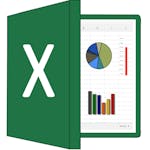Excel Cheat Sheet: Top 50 Excel Formulas
This cheat sheet is a valuable resource for anyone who wants to learn Excel formulas. It is a quick and easy way to learn about the most common Excel functions and formulas, and it can help you to perform calculations, analyze data, and create powerful spreadsheets.
Excel is a popular spreadsheet program that allows users to organize and manipulate data efficiently. Excel formulas enable you to perform various calculations, automate tasks, and extract meaningful insights from your data. Using an Excel formula cheat sheet, you can quickly reference and understand the syntax and usage of the most commonly used functions. This will empower you to leverage the full potential of Excel in data analysis, financial modeling, reporting, and other tasks, making your spreadsheets more effective and efficient.
Excel Cheat Sheet: Top 50 Excel Formulas
This cheat sheet is a valuable resource for anyone who wants to learn Excel formulas. It is a quick and easy way to learn about the most common Excel functions and formulas, and it can help you to perform calculations, analyze data, and create powerful spreadsheets.
Excel is a popular spreadsheet program that allows users to organize and manipulate data efficiently. Excel formulas enable you to perform various calculations, automate tasks, and extract meaningful insights from your data. Using an Excel formula cheat sheet, you can quickly reference and understand the syntax and usage of the most commonly used functions. This will empower you to leverage the full potential of Excel in data analysis, financial modeling, reporting, and other tasks, making your spreadsheets more effective and efficient.
Top 50 Excel Formulas
VLOOKUP: Searches for a value in the leftmost column of a table and returns a corresponding value from a specified column. Example: =VLOOKUP(A2, B2:C10, 2, FALSE)
SUM: Adds up a range of cells. Example: =SUM(A1:A10)
IF: Performs a conditional test and returns different values based on the result. Example: =IF(A1>10, "High", "Low")
COUNT: Counts the number of cells in a range that contains numbers. Example: =COUNT(A1:A10)
AVERAGE: Calculates the average of a range of cells. Example: =AVERAGE(A1:A10)
SUMIF: Adds up the cells that meet a specific condition. Example: =SUMIF(A1:A10, ">50")
INDEX: Returns the value of a cell in a specified row and column. Example: =INDEX(A1:C10, 5, 2)
MATCH: Finds the position of a value in a range. Example: =MATCH(A1, B1:B10, 0)
CONCATENATE: Joins two or more text strings together. Example: =CONCATENATE(A1, " ", B1)
COUNTIF: Counts the number of cells that meet a specific condition. Example: =COUNTIF(A1:A10, ">50")
IFERROR: Checks if a formula produces an error and returns a specified value if true. Example: =IFERROR(A1/B1, "Error")
LEFT: Extracts a specified number of characters from the beginning of a text string. Example: =LEFT(A1, 3)
RIGHT: Extracts a specified number of characters from the end of a text string. Example: =RIGHT(A1, 2)
MID: Extracts a specified number of characters from a text string, starting at a specified position. Example: =MID(A1, 2, 4)
LEN: Returns the number of characters in a text string. Example: =LEN(A1)
DATE: Returns the serial number of a specific date. Example: =DATE(2022, 3, 15)
NOW: Returns the current date and time. Example: =NOW()
INDIRECT: Converts a text string into a valid cell reference. Example: =INDIRECT("A1")
TRIM: Removes leading and trailing spaces from a text string. Example: =TRIM(A1)
SUBSTITUTE: Replaces specific text in a text string with new text. Example: =SUBSTITUTE(A1, "apple", "orange")
RANK: Returns the rank of a number in a list of numbers. Example: =RANK(A1, A1:A10)
MAX: Finds the maximum value in a range of cells. Example: =MAX(A1:A10)
MIN: Finds the minimum value in a range of cells. Example: =MIN(A1:A10)
ROUND: Rounds a number to a specified number of decimal places. Example: =ROUND(A1, 2)
NETWORKDAYS: Calculates the number of working days
TEXT: Converts a value to text in a specific format. Example: =TEXT(A1, "yyyy-mm-dd")
RAND: Returns a random number between 0 and 1. Example: =RAND()
IFNA: Checks if a formula returns the #N/A error and returns a specified value if true. Example: =IFNA(VLOOKUP(A1, B1:C10, 2, FALSE), "Not Found")
HLOOKUP: Searches for a value in the top row of a table and returns a corresponding value from a specified row. Example: =HLOOKUP(A1, A1:D10, 3, FALSE)
CONCAT: Joins two or more text strings together. Example: =CONCAT(A1, " ", B1, " ", C1)
TODAY: Returns the current date. Example: =TODAY()
OR: Checks multiple conditions and returns true if any of them are true. Example: =OR(A1>10, B1="Yes")
AND: Checks multiple conditions and returns true if all of them are true. Example: =AND(A1>10, B1="Yes")
DATEVALUE: Converts a date in the text format to a serial number. Example: =DATEVALUE("2022-03-15")
ROUNDUP: Rounds a number up to a specified number of decimal places. Example: =ROUNDUP(A1, 0)
ROUNDDOWN: Rounds a number down to a specified number of decimal places. Example: =ROUNDDOWN(A1, 0)
ISNUMBER: Checks if a value is a number and returns true or false. Example: =ISNUMBER(A1)
IFBLANK: Checks if a cell is blank and returns a specified value if true. Example: =IFBLANK(A1, "Empty")
PROPER: Converts the first letter of each word in a text string to uppercase. Example: =PROPER(A1)
MEDIAN: Calculates the median of a range of numbers. Example: =MEDIAN(A1:A10)
MODE: Returns the most frequently occurring value in a range of numbers. Example: =MODE(A1:A10)
DAY: Extracts the day value from a date. Example: =DAY(A1)
MONTH: Extracts the month value from a date. Example: =MONTH(A1)
YEAR: Extracts the year value from a date. Example: =YEAR(A1)
TRANSPOSE: Transposes the rows and columns of a range. Example: Enter the formula, then select a range and press Ctrl + Shift + Enter.
PMT: Calculates the payment amount for a loan based on constant payments and a constant interest rate. Example: =PMT(0.05/12, 60, 10000)
PRODUCT: Multiplies the values in a range of cells. Example: =PRODUCT(A1:A10)
STDEV: Estimates the standard deviation based on a sample from a population. Example: =STDEV(A1:A10)
LEFTB: Extracts a specified number of bytes from the beginning of a text string. Example: =LEFTB(A1, 3)
FIND: Finds the position of a specific character or text within a text string. Example: =FIND("a", A1)
Learn more Excel skills on Coursera.
Excel Courses | Excel Data Analysis Courses | Pivot Tables Courses | Microsoft Power BI Courses | Excel Macros Courses | Excel VBA Courses | Data Visualization Courses | Business Intelligence Courses | SQL Courses | Financial Modeling Courses
 Join a community of over 100 million learners from around the world
Join a community of over 100 million learners from around the world Learn from more than 200 leading universities and industry educators.
Learn from more than 200 leading universities and industry educators. 70% of all learners who have stated a career goal and completed a course report outcomes such as gaining confidence, improving work performance, or selecting a new career path.
70% of all learners who have stated a career goal and completed a course report outcomes such as gaining confidence, improving work performance, or selecting a new career path.- 100% online
- Flexible schedule
- Mobile learning
- Videos and readings from professors at world-renowned universities and industry leaders
- Practice quizzes
Can’t decide what is right for you?
Try the full learning experience for most courses free for 7 days.Register to learn with Coursera’s community of 87 million learners around the world





